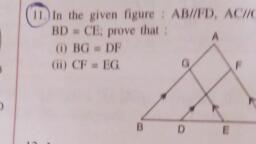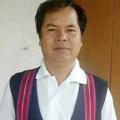Question 1 :
Either pair of opposite angles of a cyclic quadrilateral are _____________.
Question 2 :
ABCD is a parallelogram. The circle through A, B and C intersect CD (produced if necessary) at E. Is AE = AD?
Question 3 :
<img style='object-fit:contain' src='https://teachmint.storage.googleapis.com/question_assets/cbse_ncert/61b1d114f59b460d7261f3c5.PNG' />
In the above figure, if $\angle ABC = 20^{\circ}$, then $\angle AOC$ is equal to
Question 4 :
The longest chord of a circle is a ______________ of the circle.
Question 5 :
State Yes or No: AB and AC are two chords of a circle of radius r such that AB = 2AC. If p and q are the distances of AB and AC from the centre, then $4q^2=p^2+3r^2$ .
Question 6 :
ABC and ADC are two right triangles with common hypotenuse AC. Is ∠ CAD = ∠ CBD?
Question 7 :
A circle has only finite number of equal chords. TRUE or FALSE?
Question 8 :
Draw different pairs of circles. What is the maximum number of common points?
Question 9 :
State whether the given statement is true or false:- If A, B, C and D are four points such that $\angle BAC=45^{\circ}$ and $\angle BDC=45^{\circ}$, then A, B, C, D are concyclic.
Question 10 :
<img style='object-fit:contain' src='https://teachmint.storage.googleapis.com/question_assets/cbse_ncert/61b1d11af59b460d7261f3ce.PNG' />
In the above figure, $\angle OAB=30^{\circ}$ and $\angle OCB=57^{\circ}$. Find $\angle BOC$.
Question 11 :
AC and BD are chords of a circle which bisect each other. ABCD is a ____________.
Question 12 :
A circle is drawn with any side of a rhombus as diameter, does it pass through the point of intersection of its diagonals?
Question 13 :
State true or false: ABCD is such a quadrilateral that A is the centre of the circle passing through B, C and D. Then $\angle CBD\ +\ \angle CDB\ =\frac{1}{2}\angle BAD$.
Question 14 :
If a circle is divided into three equal arcs, each is a major arc. TRUE or FALSE?
Question 15 :
Angles in the same segment of a circle are not necessarily equal. TRUE or FALSE?
Question 17 :
If circles are drawn taking two sides of a triangle as diameters, the point of intersection of these circles do not lie necessarily on the third side. TRUE or FALSE ?
Question 18 :
<img style='object-fit:contain' src='https://teachmint.storage.googleapis.com/question_assets/cbse_ncert/61b1d1a2f59b460d7261f493.png' />
In the above fig, the larger segment is called the ______________________.
Question 19 :
<img style='object-fit:contain' src='https://teachmint.storage.googleapis.com/question_assets/cbse_ncert/61b1d1aaf59b460d7261f49e.png' />
In the above fig, A, B, C and D are four points on a circle. AC and BD intersect at a point E such that ∠ BEC = 130° and ∠ ECD = 20°. Find ∠ BAC.
Question 20 :
State true or false: If non-parallel sides of a trapezium are equal, then it is cyclic.
Question 21 :
A quadrilateral ABCD is called _________ if all the four vertices of it lie on a circle.
Question 22 :
If two equal chords of a circle intersect within the circle, the segments of one chord is equal to corresponding segments of the other chord. TRUE or FALSE?
Question 23 :
An arc is a _________________ when its ends are the ends of a diameter.
Question 24 :
<img style='object-fit:contain' src='https://teachmint.storage.googleapis.com/question_assets/cbse_ncert/61b1d1a0f59b460d7261f490.png' />
In the above fig, segment AB is the _____________ of the circle.
Question 25 :
State whether the given statement is true or false:- Two chords of a circle of lengths 10 cm and 8 cm are at the distances 8.0 cm and 3.5 cm, respectively from the centre.



























